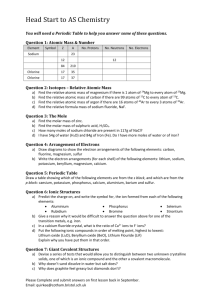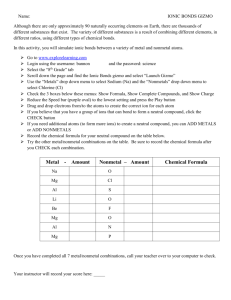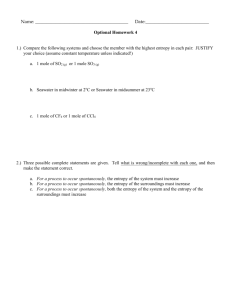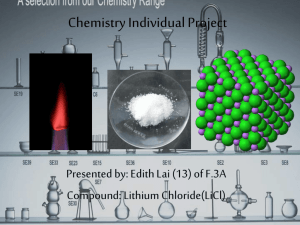Chemical Reactions
advertisement
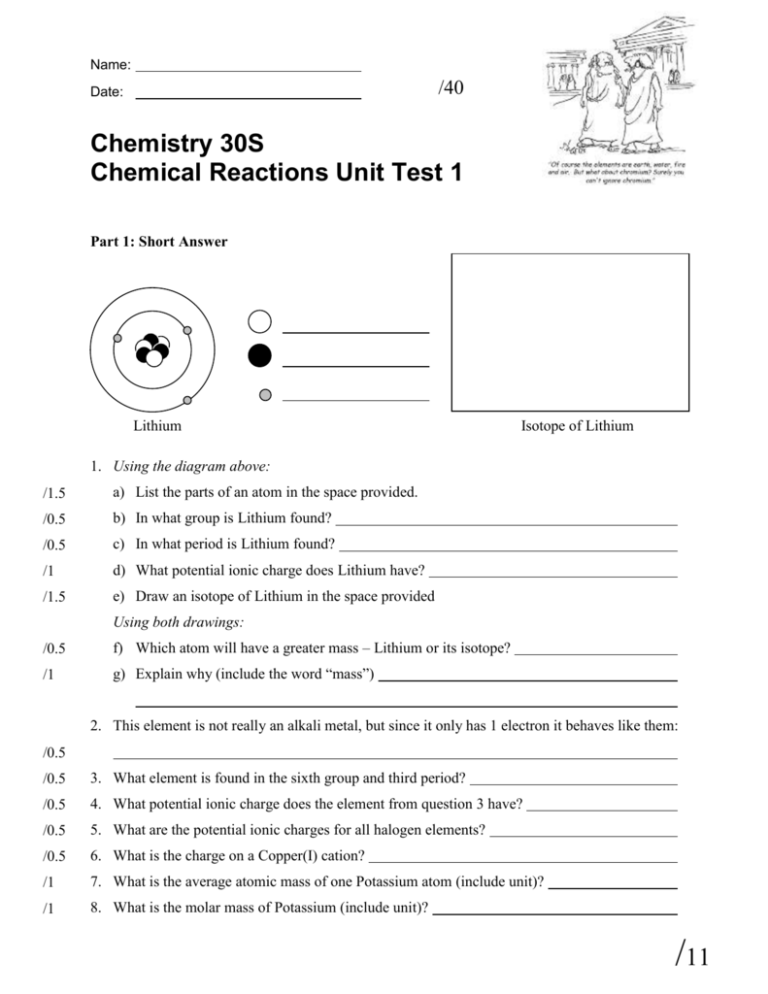
Name: /40 Date: Chemistry 30S Chemical Reactions Unit Test 1 Part 1: Short Answer Lithium Isotope of Lithium 1. Using the diagram above: /1.5 a) List the parts of an atom in the space provided. /0.5 b) In what group is Lithium found? /0.5 c) In what period is Lithium found? /1 d) What potential ionic charge does Lithium have? /1.5 e) Draw an isotope of Lithium in the space provided Using both drawings: /0.5 f) Which atom will have a greater mass – Lithium or its isotope? /1 g) Explain why (include the word “mass”) 2. This element is not really an alkali metal, but since it only has 1 electron it behaves like them: /0.5 /0.5 3. What element is found in the sixth group and third period? /0.5 4. What potential ionic charge does the element from question 3 have? /0.5 5. What are the potential ionic charges for all halogen elements? /0.5 6. What is the charge on a Copper(I) cation? /1 7. What is the average atomic mass of one Potassium atom (include unit)? /1 8. What is the molar mass of Potassium (include unit)? /11 9. Using the ionic compound naming rules please either write the name of the ionic compound or the molecular formula (make sure the charges are balanced). You may use the Periodic Table and Appendix 1: Names, Formulas and Charges of Some Common Ions that are included with this test: Formula Name /0.5 a) Potassium Sulfide /0.5 b) Copper(II) Carbonate /0.5 c) LiBr /0.5 d) BaF2 /1 e) (NH4)2O /1 f) FePO4 /1 g) CoS Part 2: Long Answer /4 1. Silver exists as 51.84% 107Ag and 48.16% 109Ag. The actual mass of 107Ag is 106.90509 amu and the actual mass of 109Ag is 108.90476. What is the average atomic mass of silver? Round your calculations to four decimal places and show a written comparison to the figure on the periodic table. /0.5 2. a) When two ions form an ionic compound it is call a /2.5 b) Using the diagram below, show what happens when Potassium + Iodine react to form Potassium Iodide. Draw the valence electrons on the atoms before and after the ionic compound is formed and indicate ionic charges where appropriate. K /1 reaction. + I K I c) Give a brief (1 sentence) explanation of what is happening: /13 /1 /3 d) Calculate the atomic mass of Potassium Iodide. Show your work: 3. For the following questions write the reaction symbolically and identify the reaction type: a) Silver Nitrate + Sodium Chloride react to form Silver Chloride + Sodium Nitrate Reaction Type: _______ + _________ _________ + __________ /3 ______________________________ b) Calcium Chloride breaks down into Calcium and Chlorine Reaction Type: _________ _________ + __________ ______________________________ 4. For the following questions use the given reaction type to predict the product. /2 a) Single Displacement Zn + H2SO4 /2 b) Combustion (this will not be a balanced chemical equation) C2H6 + O2 /3 5. Use pictures, words or an analogy to explain the concept of a mole. Be sure to mention the terms atom, molecule, and Avagadro’s Number (6.02 x 1023). /2 6. Using either words, pictures, or both explain how a coefficient 2 (2A) is defferent from a subscript 2 (A2). /16
